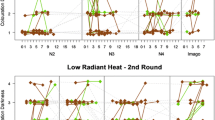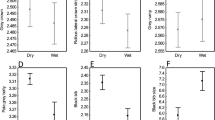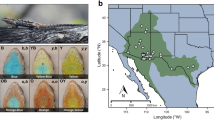Abstract
Ectothermic animals rely on external heat sources and behavioral thermoregulation to control body temperature, and are characterized by possessing physiological and behavioural traits which are temperature dependent. It has therefore been suggested that constraints on the range of body temperatures available to individuals imposed by phenotypic properties, such as coloration, may translate into differential fitness and selection against thermally inferior phenotypes. In this paper, I report an association between thermal preferences and thermal capacity (the ability to warm up when insolated) across different genetically coded color morphs of the pygmy grasshopper Tetrix subulata. Data on behavioral thermoregulation of individuals in a laboratory thermal gradient revealed a preference for higher body temperatures in females than in males, and significant variation among colour morphs in preferred body temperatures in females, but not in males. The variation in females was in perfect accordance with estimates of morph-specific differences in thermal capacity. Thus, dark morphs not only attain higher temperatures when exposed to augmented illumination, but also prefer higher body temperatures, compared to paler morphs. This intra-population divergence probably reflects an underlying variation among colour morphs in temperature optima, and is consistent with the notion that coloration, behaviour and physiology evolve in concert.
Similar content being viewed by others
References
Adolph, S.C. and Porter, W.P. (1993) Temperature, activity, and lizard life histories. Am. Nat. 142, 273–295.
Bauwens, D., Garland, T., Castilla, A.M. and Van Damme, R. (1995) Evolution of sprint speed in lacertid lizards: morphological, physiological, and behavioural covariation. Evolution 49, 848–863.
Brakefield, P.M. and Willmer, P.G. (1985) The basis of thermal melanism in the ladybird beetle Adalia bipunctata. Differences in reflectance and thermal properties between morphs. Heredity 54, 9–14.
Brodie, E.D. III. (1989) Genetic correlation between morphology and antipredator behaviour in natural populations of the garter snake Thamnophis ordinoides. Nature 342, 542–543.
Burnett, T. (1960) Influences of natural temperature and controlled host densitites on oviposition of an insect parasite. Am. Nat. 94, 239–248.
Casey, T.M. (1981) Behavioral mechanisms of thermoregulation. In B. Heinrich (ed) Insect Thermoregulation. John Wiley and Sons, New York, pp. 79–114.
De Jong, P.W., Gussekloo, S.W.S. and Brakefield, P.M. (1996) Differences in thermal balance, body temperature and activity between non-melanic and melanic two-spot ladybird beetles (Adalia bipunctata) under controlled conditions. J. Exper. Biol. 199, 2655–2666.
Digby, P.S.B. (1955) Factors affecting the temperature excess of insects in sunshine. J. Exper. Biol. 32, 279–298.
Fisher, R.A. (1939) Selective forces in wild populations of Paratettix texanus. Annals of Eugenics 9, 109–122.
Forsman, A. (1995a) Heating rates and body temperature variation in melanistic and zigzag Vipera berus: does colour make a difference? Annales Zool. Fenn. 32, 365–374.
Forsman, A. (1995b) Opposing fitness consequences of colour pattern in male and female snakes. J. Evol. Biol. 8, 53–70.
Forsman, A. (1997) Thermal capacity of different colour morphs in the pygmy grasshopper Tetrix subulata. Annales Zool. Fenn. 34, 145–149.
Forsman, A. (1999a) Temperature influence on escape behaviour in two species of pygmy grasshoppers. Ecoscience 6, 35–40.
Forsman, A. (1999b) Variation in thermal sensitivity of performance among color morphs of the pygmy grasshopper, Tetrix subulata. J. Evol. Biol. 12, 869–878.
Forsman, A. (1999c) Reproductive life history variation among colour morphs of the pygmy grasshopper, Tetrix subulata. Biol. J. Linn. Soc. 67, 247–261.
Forsman, A. and Appelqvist, S. (1998) Visual predators impose correlational selection on prey color pattern and behavior. Behav. Ecol. 9, 409–413.
Forsman, A. and Appelqvist, S. (1999) Experimental manipulation reveals differential effects of colour pattern on survival in male and female pygmy grasshoppers. J. Evol. Biol. 12, 391–401.
Gibson, A.R. and Falls, B. (1979) Thermal biology of the common garter snake Thamnophis sirtalis L. II. The effects of melanism. Oecologia 43, 99–109.
Gibson, A.R. and Falls, B. (1988) Melanism in the common garter snake: a Lake Erie phenomenon. In J.F. Downhower (ed) The Biogeography of the Island Region of Western Lake Erie. Ohio State University Press, Columbus, pp. 233–245.
Gilchrist, G.W. (1996) A quantitative genetic analysis of thermal sensitivity in the locomotor performance curve of Aphidius ervi. Evolution 50, 1560–1572.
Harrison, J.F., Phillips, J.E. and Gleeson, T.T. (1991) Activity physiology of the two-striped grasshopper, Melanoplus bivittatus: gas exchange, hemolymph acid-base status, lactate production, and the effect of temperature. Phys. Zool. 64, 451–472.
Holst, K.T. (1986) The Saltatoria of northern Europe. Fauna Entomol. Scand. 16, 1–127.
Huey, R.B. (1982) Temperature, physiology, and the ecology of reptiles. In C. Gans and F.H. Pough (eds) Biology of the Reptilia, Vol. 12. Academic Press, New York, pp. 25–91.
Huey, R.B. and Bennett, A.F. (1987) Phylogenetic studies of coadaptation: preferred temperatures versus optimal performance temperatures of lizards. Evolution 41, 1098–1115.
Huey, R.B. and Kingsolver, J.G. (1989) Evolution of thermal sensitivity of ectotherm performance. Trends Ecol. Evol. 4, 131–135.
Huey, R.B. and Kingsolver, J.G. (1993) Evolution of resistance to high temperature in ectotherms. Am. Nat. 142, S21-S46.
Huey, R.B., Peterson, C.R., Arnold, S.J. and Porter, W.P. (1989) Hot rocks and not-so hot rocks: retreat site selection by garter snakes and its thermal consequences. Ecology 70, 931–944.
Kingsolver, J.G. (1996) Experimental manipulation of wing pigment pattern and urvival in western white butterflies. Am. Nat. 147, 296–306.
Kingsolver, J.G. and Watt, W.B. (1983) Thermoregulatory strategies in Colias butterflies: thermal stress and the limits to adaptation in temporally varying environements. Am. Nat. 121, 32–55.
Krstevska, B. and Hoffman, A.A. (1994) The effects of acclimation and rearing conditions on the response of tropical and temperate population of Drosophila melanogaster and D. simulans to a temperature gradient. J. Insect Behav. 7, 279–288.
Lactin, D.J. and Johnson, D.L. (1996) Behavioural optimization of body temperature by nymphal grasshoppers (Melanoplus sanguinipes, Orthoptera: Acrididae) in temperature gradients established using incandescent bulbs. J. Thermal Biol. 21, 231–238.
Lank, D., Smith, C.M., Hanotte, O., Burke, T. and Cooke, F. (1995) Genetic polymorphism for alternative mating behaviour in lekking male ruff Philomachus pugnax. Nature 348, 59–62.
Malvin, G.M. and Wood, S.C. (1991) Behavioural thermoregulation of the toad, Bufo marinus: effects of air humidity. J. Exper. Zool. 258, 322–326.
McDaniel, R., Hostert, E.E. and Seager, R.D. (1995) Acclimation and adaptive behavior of Drosophila robusta and D. tripunctata adults in response to combined temperature and dessication stress. Amer. Midl. Nat. 133, 52–59.
Nabours, R.K. (1929) The genetics of the Tettigidae (Grouse locusts). Bibliographia Genetica, 27–104. Verlag M Nijhoff, Den Haag, Netherlands.
Peterson, C.R. (1987) Daily variation in the body temepratures of free-ranging garter snakes. Ecology 68, 160–169.
Peterson, C.R., Gibson, A.R. and Dorcas, M.E. (1993) Snake thermal ecology: the causes and consequences of body-temperature variation. In R.A. Seigel and J.T. Collins (eds) Snakes-Ecology and Behavior. McGraw Hill, New York, pp. 241–314.
Rice, W.R. and Gaines, S.D. (1994) Extending nondirectional heterogeneity tests to evaluate simply ordered alternative hypotheses. Proc. Natl. Acad. Sci. USA 91, 225–226.
Rowell, C.H.F. (1971) The variable coloration of the Acridoid grasshoppers. In J.W.L. Beament, J.E. Treherne and V.B. Wigglesworth (eds) Advances in Insect Physiology, Vol. 8. Academic Press, London, pp. 145–198.
SAS Institute Inc. (1988) SAS/STAT User's Guide, Release 6.03 Edition. Cary, North Carolina: SAS Institute Inc.
Scwarzkopf, L. and Shine, R. (1991) Thermal biology of reproduction in viviparous skinks, Eulamprus tympanum: why do gravid lizards bask more? Oecologia 88, 562–569.
Seigel, S. and Castellan, N.J. Jr. (1988) Nonparametric Statistics for the Behavioral Sciences, 2nd edn. New York: McGraw-Hill.
Sokal, R.R. and Rohlf, F.J. (1981) Biometry, 2nd edn. W. H. Freeman and Company, New York.
Stevenson, R.D. (1985) Body size and limits to the daily range of body temperatures in terrestrial ectotherms. Am. Nat. 125, 102–117.
Stewart, L.A. and Dixon, A.F.G. (1989) Why big species of ladybird beetles are not melanic. Funct. Ecol. 3, 165–177.
Watt, W.B. (1968) Adaptive significance of pigment polymorphism in Colias butterflies. I. Variation of melanin pigment in relation to thermoregulation. Evolution 22, 437–458.
Willmer, P. (1991) Thermal biology and mate acquisition in ectotherms. Trends Ecol. Evol. 6, 396–399.
Willmer, P.G. and Unwin, D.M. (1981) Field analyses of insect heat budgets: reflectance, size and heating rates. Ocologia 50, 250–255.
Yamamoto, A.H. (1994) Temperature preferences of Drosophila immigrans and D. virilis: intra-and inter-population genetic variation. Japanese J. Genetics 69, 67–76.
Author information
Authors and Affiliations
Rights and permissions
About this article
Cite this article
Forsman, A. Some like it hot: Intra-Population Variation in behavioral Thermoregulation in Color-Polymorphic pygmy Grasshoppers. Evolutionary Ecology 14, 25–38 (2000). https://doi.org/10.1023/A:1011024320725
Issue Date:
DOI: https://doi.org/10.1023/A:1011024320725




